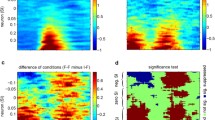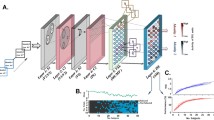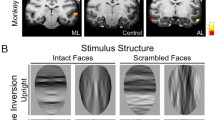Abstract
Understanding the neural mechanisms of object and face recognition is one of the fundamental challenges of visual neuroscience. The neurons in inferior temporal (IT) cortex have been reported to exhibit dynamic responses to face stimuli. However, little is known about how the dynamic properties of IT neurons emerge in the face information processing. To address this issue, we made a model of IT cortex, which performs face perception via an interaction between different IT networks. The model was based on the face information processed by three resolution maps in early visual areas. The network model of IT cortex consists of four kinds of networks, in which the information about a whole face is combined with the information about its face parts and their arrangements. We show here that the learning of face stimuli makes the functional connections between these IT networks, causing a high spike correlation of IT neuron pairs. A dynamic property of subthreshold membrane potential of IT neuron, produced by Hodgkin–Huxley model, enables the coordination of temporal information without changing the firing rate, providing the basis of the mechanism underlying face perception. We show also that the hierarchical processing of face information allows IT cortex to perform a “coarse-to-fine” processing of face information. The results presented here seem to be compatible with experimental data about dynamic properties of IT neurons.















Similar content being viewed by others
References
Afraz S-R, Kiani R, Esteky H (2006) Microstimulation of inferotemporal cortex influences face categorization. Nature 442:692–695
Baker CI, Behrmann M, Olson C (2002) Impact of learning on representation of parts and wholes in monkey inferotemporal cortex. Nat Neurosci 5:1210–1216
Bakker A, Kirwan CB, Miller M, Stark CE (2008) Pattern separation in the human hippocampal CA3 and dentate gyrus. Science 319:1640–1642
Desimone R, Albright TD, Gross CG, Bruce C (1984) Stimulus-selective properties of inferior temporal neurons in the macaque. J Neurosci 4:2051–2062
Engel AK, Fries P, Singer W (2001) Dynamic predictions: oscillations and synchrony in top–down processing. Nat Rev Neurosci 2:704–716
Freedman DJ, Riesenhuber M, Poggio T, Miller EK (2003) A comparison of primate prefrontal and inferior temporal cortices during visual categorization. J Neurosci 23:5235–5246
Freedman DJ, Riesenhuber M, Poggio T, Miller EK (2006) Experience-dependent sharpening of visual shape selectivity in inferior temporal cortex. Cereb Cortex 16:1631–1644
Freiwald WA, Tsao DY (2010) Functional compartmentalization and viewpoint generalization within the macaque face-processing system. Science 330:845–851
Frie P, Nikolic D, Singer W (2007) The gamma cycle. Trends Neurosci 30:309–316
Fujita I, Tanaka K, Ito M, Cheng K (1992) Columns for visual features of objects in monkey inferotemporal cortex. Nature 360:343–346
Fujita K, Kashimori Y, Kambara T (2007) Spatiotemporal burst coding for extracting features of spatiotemporally varying stimuli. Biol Cybern 97:293–305
Gallant JL, Braun J, Van Essen DC (1993) Selectivity for polar, hyperbolic, and Cartesian gratings in macaque visual cortex. Science 259:100–103
Gray CM, Konig P, Engel AK, Singer W (1989) Oscillatory responses in cat visual cortex exhibit inter-columnar synchronization which reflects global stimulus properties. Nature 338:334–337
Gross CG (2005) Processing the facial image: a brief history. Am Psychol 60:755–763
Gross CG, Rocha-Miranda CE, Bender DB (1972) Visual properties of neurons in inferotemporal cortex of the macaque. J Neurophysiol 35:96–111
Hirabayashi T, Miyashita Y (2005) Dynamically modulated spike correlation in monkey inferior temporal cortex depending on the feature configuration within a whole object. J Neurosci 25:10299–10307
Hodgkin AL, Huxley AF (1952) A quantitative description of membrane current and its application to conduction and exciatation in nerve. J Physiol 117:500–544
Hubel DH, Wiesel TN (1962) Receptive fields, binocular interaction and functional architecture in the cat’s visual cortex. J Physiol 160:106–154
Ito M, Komatsu H (2004) Representation of angles embedded within contour stimuli in area V2 of macaque monkeys. J Neurosci 24:3313–3324
Kanwisher N, MacDermott J, Chun M (1997) The fusiform face area: a module in human extrastriate cortex specialized for the perception of faces. J Neurosci 17:4302–4311
Kashimori Y, Ichinose Y, Fujita K (2007) A functional role of interaction between IT cortex and PF cortex in visual categorization task. Neurocomputing 70:1813–1818
Kiani R, Esteky H, Tanaka K (2005) Differences in onset latency of macaque inferotemporal neuronal responses to primate and non-primate faces. J Neurophysiol 94:1587–1596
Kobatake E, Tanaka K (1994) Neural selectivities to complex object features in the ventral visual pathway of the macaque cerebral cortex. J Neurophysiol 71:856–867
Kobatake E, Wang G, Tanaka K (1998) Effects of shape-discrimination training on the selectivity of inferotemporal cells in adult monkeys. J Neurophysiol 80:324–330
Kohonen T (1995) Self-organized maps. Springer, Berlin
Leopold DA, O’Toole AJ, Vetter T, Branz N (2001) Prototype-referenced shape encoding revealed by high-level aftereffects. Nat Neurosci 4:89–94
Leopold DA, Bondar IV, Giese MA (2006) Norm-based face encoding by single neurons in the monkey inferotemporal cortex. Nature 442:572–575
Logothetis NK, Sheinberg DL (1996) Visual object recognition. Annu Rev Neurosci 19:577–621
Logothetis NK, Pauls J, Poggio T (1995) Shape representation in the inferior temporal cortex in monkeys. Curr Biol 5:552–563
Messinger A, Squire LR, Zola SM, Albright TD (2005) Neural representations of stimulus associations develop in the temporal lobe during learning. Proc Natl Acad Sci USA 98:12239–12244
Miyashita Y (2004) Cognitive memory: cellular and network mechanisms and their top–down control. Science 306:435–440
Pasupathy A, Connor CE (1999) Responses of contour features of neurons in cortical area MT in alert and anaesthetized macaque monkeys. Nature 414:905–908
Perrett DI, Rolls ET, Caan W (1982) Visual neurons responsive to faces in the monkey temporal cortex. Exp Brain Res 47:329–342
Perrett DI, Hietanen JK, Oram MW, Benson PJ, Rolls ET (1992) Organization and functions of cell responsive to faces in the temporal cortex. Phil Trans R Soc B 335:23–30
Rodriguez E, George N, Lachaux J-P, Martinerie J, Renault B, Varela FJ (1999) Perception’s shadow: long distance synchronization of human brain activity. Nature 397:430–433
Rolls ET (1984) Neurons in the cortex of the temporal lobe and in the amygdale of the monkey with responses selective for faces. Human Neurobiol 3:209–222
Rolls ET (1995) Learning mechanism in the temporal lobe visual cortex. Behav Brain Res 66:177–185
Rosenthal O, Fusi S, Hochstein S (2001) Forming classes by stimulus frequency: behavior and theory. Proc Natl Acad Sci USA 98:4265–4270
Sigala N, Logothetis NK (2002) Visual categorization shapes feature selectivity in the primate temporal cortex. Nature 415:318–320
Singer W (1999) Neuronal synchrony: a versatile code for the definition of relation? Neuron 24:49–125
Singer W, Gray CM (1995) Visual feature integration and temporal correlation hypothesis. Annu Rev Neurosci 18:555–586
Soga M, Kashimori Y (2009) Functional connections between visual areas in extracting object features critical for a visual categorization task. Vis Res 49:337–347
Sripati AP, Olson CR (2009) Representing the forest before the trees: a global advantage effect in monkey inferotemporal cortex. J Neurosci 29:7788–7796
Sugase Y, Yamane S, Ueno S, Kawano K (1999) Global and fine information coded by single neurons in the temporal visual cortex. Nature 400:869–873
Szabo M, Stetter M, Deco G, Fusi S, Giudice PD, Mattia M (2006) Learning to attend: modeling the shaping of selectivity in infero-temporal cortex in a categorization task. Biol Cybern 94:351–365
Tanaka K (1996) Inferotemporal cortex and object vision. Annu Rev Neurosci 19:109–139
Tsao DY, Freiwald WA, Knutsen TA, Mandeville JB, Tootell RB (2003) Faces and objects in macaque cerebral cortex. Nat Neurosci 6:989–995
Tsunoda K, Yamane Y, Nishizaki M, Tanifuji M (2001) Complex objects are represented in macaque inferotemporal cortex by the combination of feature columns. Nat Neurosci 4:832–838
Turchi J, Saunders RC, Mishkin M (2005) Effects of cholinergic deafferentation of the rhinal cortex on visual recognition memory in monkeys. Proc Natl Acad Sci USA 102:2158–2161
Urgerleider LG, Mishkin M (1982) Two cortical visual systems. In: Ingle DJ, Goodale MA, Mansfield RJW (eds) Analysis of visual behavior. MIT press, Cambridge, pp 549–586
Valentine T (1991) A unified account of the effects of distinctiveness, inversion, and race in face recognition. Quart J Exp Psychol A 43:161–204
Wan H, Warburton EC, Zhu XO, Koder TJ, Park Y, Aggleton JP, Cho K, Bashir ZI, Brown MW (2004) Benzodiazepine impairment of perirhinal cortical plasticity and recognition memory. Eur J Neurosci 20:2214–2224
Winters BD, Bussey TJ (2005a) Transient inactivation of perirhinal cortex disrupts encoding, retrieval, and consolidation of object recognition memory. J Neurosci 25:52–61
Winters BD, Bussey TJ (2005b) Glutamate receptors in perirhinal cortex mediate encoding, retrieval, and consolidation of object recognition memory. J Neurosci 25:4243–4251
Winters BD, Bussey TJ (2005c) Removal of cholinergic input to perirhinal cortex disrupts object recognition but not spatial working memory in the rat. Eur J Neurosci 21:2263–2270
Yamane Y, Tsunoda K, Matsumoto M, Phillips AN, Tanifuji M (2006) Representation of the spatial relationship among object parts by neuron in macaque inferotemporal cortex. J Neurophysiol 96:3147–3156
Young MP, Yamane S (1992) Sparse population coding of face in the inferotemporal cortex. Science 256:1327–1331
Zangenehour S, Chaudhuri A (2005) Patchy organization and asymmetric distribution of the neural correlates and face processing in monkey inferotemporal cortex. Curr Biol 15:993–1005
Author information
Authors and Affiliations
Corresponding author
Appendix: The synaptic weights between neurons in V4X and ITX (X = B, M, F)
Appendix: The synaptic weights between neurons in V4X and ITX (X = B, M, F)
The synaptic weights between neurons in V4X and ITX (X = B, M, F) were determined by the learning rule of Kohonen’s self-organized map (Kohonen 1995). The V4B has a retinotopic map consisting of NV4B x NV4B neurons, in which each neuron has the output of 0 or 1, depending on whether it receives the input elicited by a face stimulus, as shown in Fig. 2a. The synaptic weight of the connection from (i, j)th neuron in V4B to the neuron within kth uint in ITB layer, \( w_{V4B - ITB} (k,ij) \), is updated by \( \Updelta w_{V4B - ITB} (k,ij) \), given by
where Xij,V4B is the output of (i, j)th V4B neuron and λ1 is the learning rate. The parameter values used were: NV4B = 11, λ1 = 0.01.
The V4M has a retinotopic map consisting of NV4M x NV4M neurons, which has the same size as V4B, as shown in Fig. 2b. The V4M neurons encode the information about the relative position of the face parts chosen by attention. When attention is directed to the position (i0, j0) included in a face part, the output of (i, j)th V4M neuron, \( X_{ij,V4M} \), is determined by
Then the synaptic weight of the connection from (i, j)th neuron in V4M to kth neuron within lth unit in ITM layer is updated by \( \Updelta w_{V4M - ITM} (kl,ij) \), given by
The synaptic weights of ITM neurons within unit were slightly modulated so as to have different sensitivities to the output of V4M. The parameter values were: NV4M = 11, d = 1, and λ2 = 0.01.
The V4F consists of NV4F x NV4F hypercolumns, each of which contains NL columns, as shown in Fig. 2c. These neurons in the columns encode local curvatures of a face part chosen by attention. The V4F represents only local features, in contrast to the representations of global face by V4B and V4M. Thus the local face features encoded by V4F is a complement to the face features encoded by V4B and V4M. The synaptic weights between ITF and V4F were determined by the learning rules similar to Eqs. (15–17). The parameter values used were: NV4F = 3, NL = 10, and the learning rate was set at 0.01.
Rights and permissions
About this article
Cite this article
Yamada, Y., Kashimori, Y. Neural mechanism of dynamic responses of neurons in inferior temporal cortex in face perception. Cogn Neurodyn 7, 23–38 (2013). https://doi.org/10.1007/s11571-012-9212-2
Received:
Revised:
Accepted:
Published:
Issue Date:
DOI: https://doi.org/10.1007/s11571-012-9212-2




